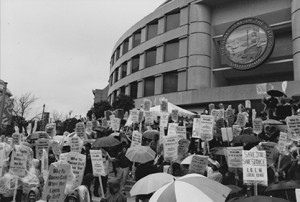In 1994 the California Public Utilities Commission announced its plan to deregulate electric service, promising it would create “customer choice” and reduce electric rates. There was no mention of service reliability nor the role of electric workers who are needed to provide it.

Nearly 1,000 IBEW members and friends turned out in pouring rain at the CPUC in San Francisco to protest downsizing in 1994. IBEW 1245 Archive photo by David Bacon
PG&E, which had already reduced its workforce by thousands, announced plans to downsize further. A thousand IBEW members faced layoffs. That December many hundreds of IBEW 1245 members rallied in the pouring rain at the CPUC in San Francisco. They chanted: “Who ya gonna call when the lights go out?”
In January, powerful storms caused prolonged outages affecting 1.4 million customers. The union persuaded the CPUC to investigate PG&E’s performance. Business Manager Jack McNally ordered pickets up at PG&E offices around the state. Union members lobbied local officials to oppose the layoffs and gave reporters guided tours of rotten power poles. But PG&E refused to cancel the layoffs.
In March, new storms inflicted major, prolonged electric outages. News reports portrayed IBEW 1245 members as selfless heroes who labored long hours to restore power despite facing layoffs. Finally, on April 5, PG&E announced it agreed with the union’s analysis and cancelled the layoffs. The CPUC, meanwhile, delayed implantation of its deregulation plan.
IBEW 1245 then negotiated stringent inspection and repair programs at PG&E. In 1997 the union helped push General Order 165 through the CPUC. This created similar inspection rules for all five of the state’s investor-owned utilities. Shortly after that, IBEW 1245 helped the newly-created Independent System Operator develop standards for maintaining the transmission system.
But the corporate hustlers and flim-flam artists pushing electric deregulation were just getting started.